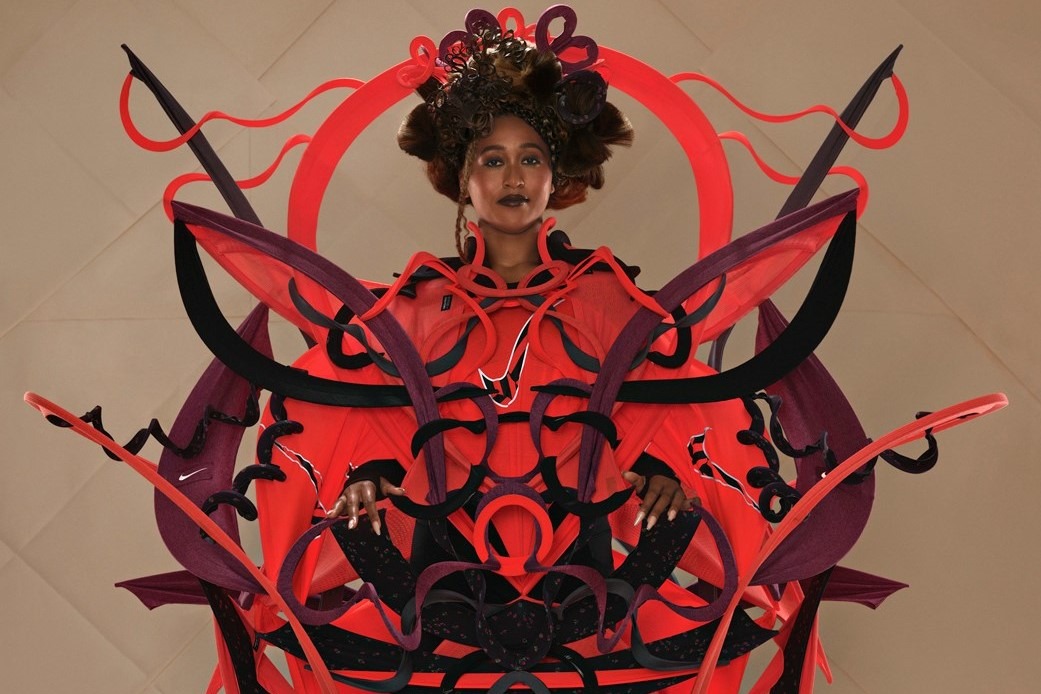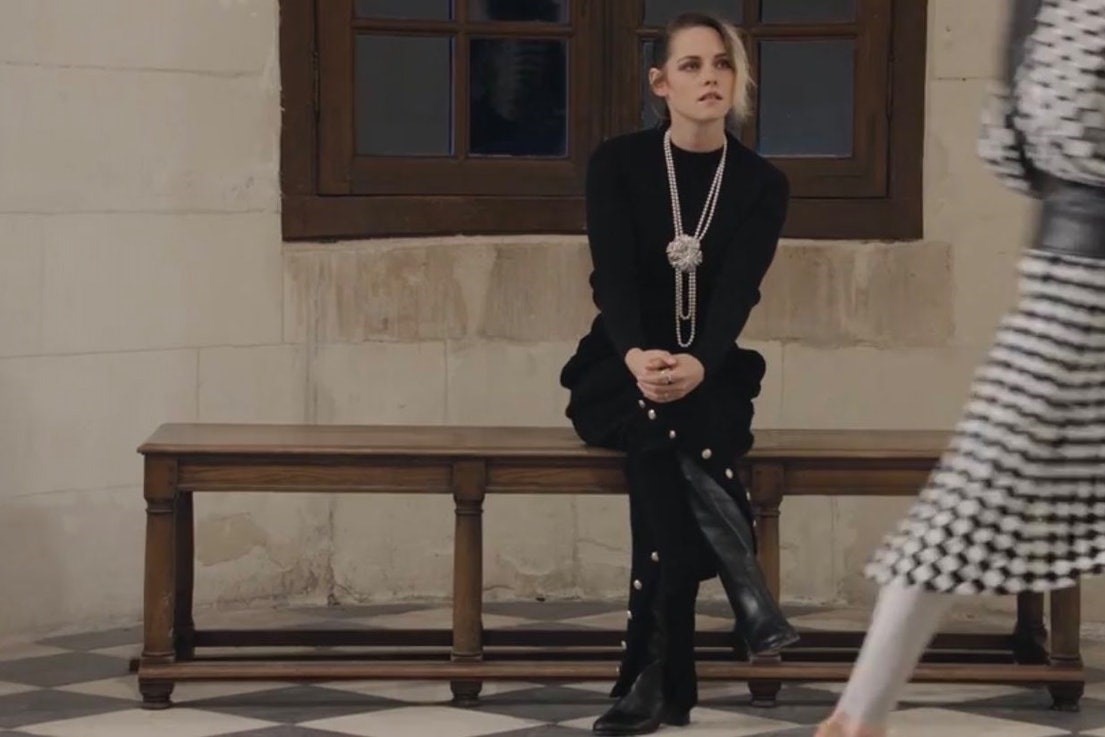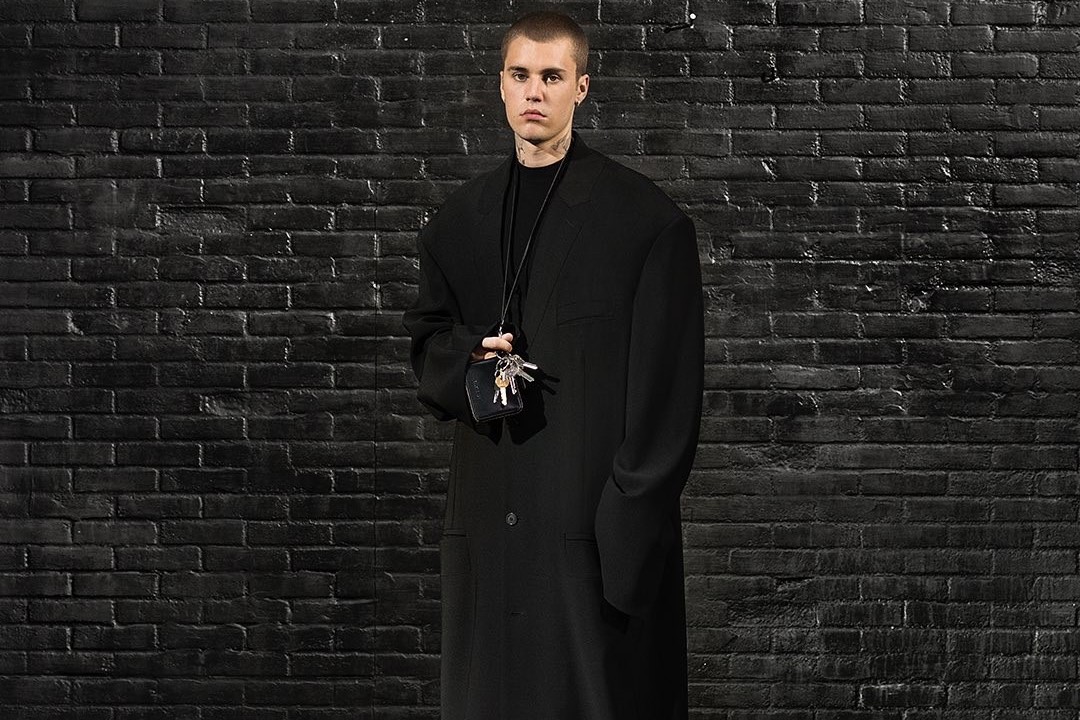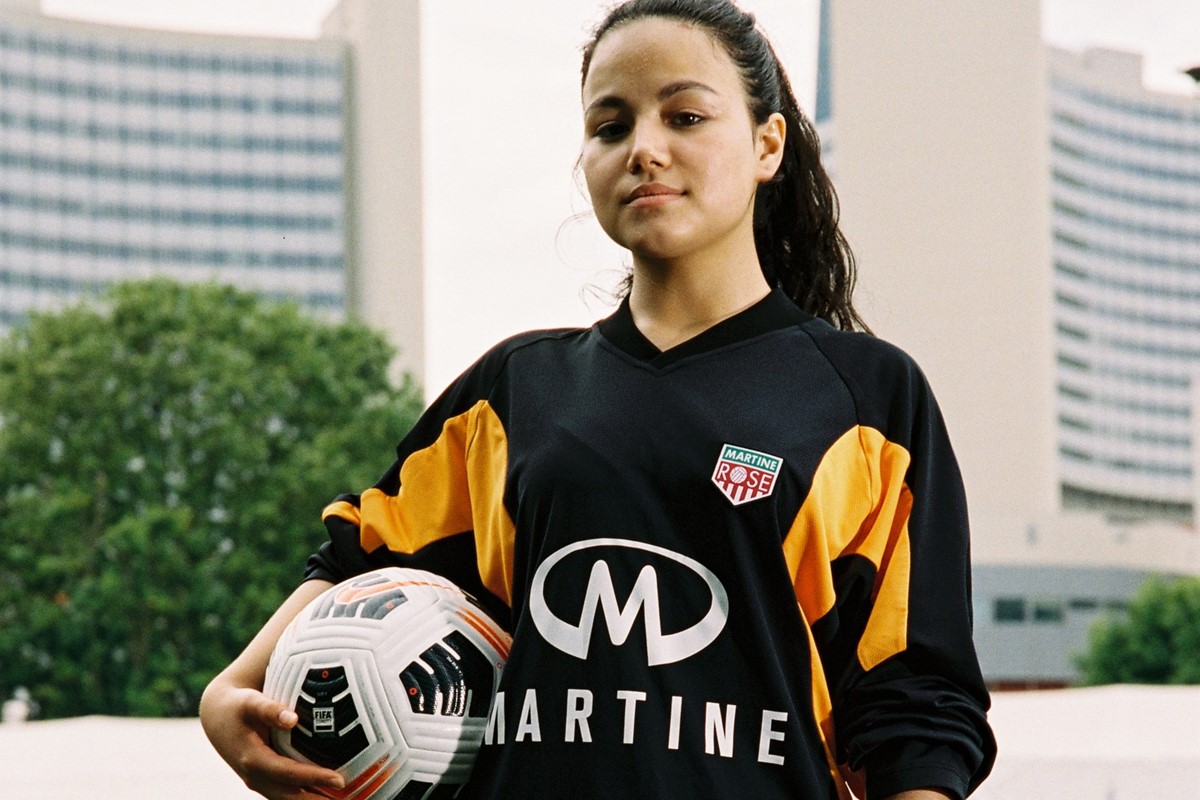
Naomi Osaka: holding court
Taken from the summer 2022 issue of Dazed. You can buy a copy of our latest issue here.
Join Dazed Club and be part of our world! You’ll get a free subscription to Dazed for a year and behind-the-scenes access to our editors, plus discounts on events, museums and festivals. Join for £5/month today.
Naomi Osaka is one of tennis’s hardest hitters, with a powerful serve that topped 125mph at the 2016 US Open. It’s a swiftness and strength that, two years later, won her the first of four Grand Slam championships, beating her idol Serena Williams at just 19 years of age.
Osaka’s most seditious statement required no super forehand or even any words. At 2020’s US Open, she wore masks sporting the names of seven Black Americans killed by police – Breonna Taylor, Elijah McClain, Ahmaud Arbery, Trayvon Martin, George Floyd, Philando Castile, and Tamir Rice. “Looking back, I think that was definitely the first time I realised that I had a voice, and it could be used in a positive way,” the 24-year-old says today. “I just went with my instincts.”

It’s these instincts that guide her towards serenity, self-worth and a success story that transcends the scoreboard. Osaka has cultivated a soft power in her break from tennis, reflecting and pursuing other creative and commercial ventures. Last year, she decided to pull out of the French Open rather than submit to press commitments stipulated by the competition. She was fined $15,000. The goal was to protect herself and her mental health first – she has spoken of the stress and self-doubt post-match media conferences give her. “The intention was never to inspire revolt, but rather to look critically at our workplace and ask if we can do better,” she wrote in an op-ed for TIME.
The moment also reflected broader pressures she sees foisted on sports stars. “I think as high-level athletes, we are accustomed to being trained to win at all costs, but actually there are more important things in life, and it doesn’t define who we are as people,” she says today. “It’s a big change, but also quite subtle at the same time.”
High-profile athletes like basketball’s Steph Curry, Usain Bolt and tennis legend Billie Jean King voiced support for Osaka. In 2021, she opened up about the bouts of depression she’s experienced since 2018 – the same year of her US Open win against Serena Williams, where she was visibly upset by the crowd’s fierce heckling. Lighting the torch at the Tokyo Olympics that year was a “career highlight”, but her quick exit and loss “sucked”. Later that summer, Osaka shared a tearful admission at the US Open: revealing that winning no longer made her happy, she announced her second hiatus from the sport.

Osaka’s stand against the relentless pillaging of athletes’ personhoods and impassioned protection of her mental health has shifted the mental health paradigm in sport. She has recently gotten behind the mental wellness startup Modern Health. Others across the world of elite sport have begun to get candid about the toll taken on their mental health, like Olympic gold medal-winning gymnast Simone Biles and record-breaking swimmer Simone Manuel. The pressure to be peerless, for mental as well as physical toughness, is being sloughed away. Tennis has always been a tradition-bound sport, steeped in rituals, match etiquette and strict dress codes – Osaka heralds a new generation.
‘Chaotic neutral’ is a descriptor derived from Dungeons and Dragons, but you’re more likely to have seen it volleyed around the internet. The term describes characters who forgo the rules, follow their hearts, and prioritise their freedom. So far, so Naomi. “As a kid growing up, I never really talked; I was the quiet one,” she wrote on Instagram in 2020. “I was the one that wanted to just skate by unnoticed and conflict-free. But the beauty of growing up is learning and seeing things for yourself… As I grow I will learn more things, but at the moment I can only hope I’m using my platform well.” Osaka is known in the public sphere as quiet and introverted, yet she’s also fast emerging as a prominent voice for social change on and off the court.
“To be upset at an athlete expressing an opinion is bizarre to me. It’s archaic and ignorant, but it doesn’t bother me too much now” – Naomi Osaka
In an essay for the New York Times, Osaka wrote that “sports have never been apolitical, and as long as they continue to be played by human beings, they won’t be”. She mentioned her personal hero, LeBron James, once told to “shut up and dribble”; Muhammad Ali, sentenced to prison during the Vietnam war for refusing to be drafted because of his religious beliefs; and Coco Gauff, a rising tennis star and passionate vocal supporter of Black Lives Matter. Osaka’s own actions in navigating acclaim and celebrity, emotional wellbeing and speaking truth to power have garnered backlash. “It’s archaic and ignorant, but it doesn’t bother me too much now,” she shares. “To be upset at an athlete expressing an opinion is bizarre to me.”
Days after George Floyd’s murder in 2020, Osaka and her boyfriend, rapper Cordae, flew to Minneapolis to participate in her first-ever protest. Osaka refused to play a semi-final match at the Western & Southern Open in August that year after a police officer shot Jacob Blake in the back seven times. She also swerved a match to appear in a tribute video to Floyd, “Racquets Down, Hands Up”, by tennis player Frances Tiafoe. In a testament to her growing influence on the sport and broader culture, the tournament rescheduled the match rather than have her forcibly withdrawn.

Osaka was born to a Japanese mother and Haitian father in Osaka, Japan. The family moved to Long Island, New York, when she was three. Her father, Leonard François, was a self-taught coach who home-schooled his two daughters and modelled his training programme on that of Richard Williams, Venus and Serena’s dad – “the blueprint”, he has said, “was there”. (Osaka loved the recent Oscar-winning biopic, King Richard.) The family moved eight-year-old Naomi – then dreaming of becoming a marine biologist – and older sister Mari to Florida to train in professional settings, spurred on by her agility and court poise. She describes her sister – who retired from tennis last year and is now a fashion designer – as her best friend: “[Mari] is an incredible artist and trailblazer. I could never beat my sister until I was about 12 or something… that pushed me and probably made me the player and person I am today.”
At the age of ten, Osaka began representing Japan – a decision made by her parents to champion her heritage – and shortly before the age of 16, she went pro. It was in 2014 that a tentative path crystallised. “It was when I beat Sam Stosur, who had won the US Open,” she says. “I was only 16 and ranked outside the top 400, so it was a shock result to some. To me, that was probably when I realised I could have a really good career.” At 18, she was playing at the Evert Tennis Academy, which boasts alumni like Lauren Davis and Madison Keys. The late Kobe Bryant was a brief but important presence in her life: “Kobe was a mentor and big brother. I miss him.”
Osaka’s biraciality has augmented her world-view. Her Australian Open triumph in 2019 made her the world’s No. 1 female tennis player and the first Asian person to take the title in either men’s or women’s tennis. “I feel like this is really my strength: being unique and also having diverse life experiences which have made me more tolerant, accepting and curious,” she says. “I can feel myself having different characteristics from each parent, which directly reflect the nationalities. I am quite soft-spoken, which is definitely from my Japanese side, but I think my fierce competitiveness comes from my Haitian side.” So far, Osaka’s life and career have been about percolating in her multitudes, which she hopes to lean into.
“I feel like this is really my strength: being unique and also having diverse life experiences which have made me more tolerant and curious” – Naomi Osaka
For this cover story, the themes and references were conceptualised around Osaka’s interest in geisha culture. She wears a sculptural, surrealist custom-made piece by Tokyo-based designer Ryunosuke Okazaki. The LVMH Prize finalist’s work pays homage to Japanese traditions, celebrating the natural, otherworldly and futuristic with rich colour palettes and exoskeleton structuring – it complements Osaka’s amorphous talent. “When I put the clothes on, I saw references to Amaterasu-Omikami, the Japanese sun goddess,” she says. “Another look felt like a reference to Tengu, a legendary creature in Japan.”
Fashion has captivated Osaka from her first trip to Tokyo’s Harajuku district as a child, with its high-octane, expressive street style. “I have always loved fashion, from the time my sister and I would sketch while driving to tournaments up until today and being able to actually design my own collec- tions,” she says. “Fashion is about taking chances, and what I love most about it is that there is never a right or wrong – it’s more about expression and art.” Osaka has been sponsored by Nike since 2019, joining the likes of Serena Williams and Megan Rapinoe as an ambassador for the brand. The partnership has borne three apparel collections that speak to her playful, colourful aesthetic and love for technical pieces – her first capsule was finished with her own personal logo, a rendition of the Japanese flag, while a shoe collab with Nike and Comme des Garçons used her signature and the handwritten mantra “home is where the heart is” as intimate motifs. She calls Nike boss Phil Knight “one of my mentors and favourite people in the world”.

“It’s such an incredibly collaborative process with Nike. I feel that, as I evolve, so do my designs,” she says of the brand, which celebrates its 50th birthday this year. “I love to be playful by mixing fun prints and patterns and using bold colours and versatile styles that can be interchangeable. My second signature collection really embodies this ap- proach and certainly blurs the lines between sport, style and culture.” This year, her sneaker game has been striking – an electric oil slick of blue, green and black for clay-court season – though the colour- ful designs might not be hopscotching Henman Hill to pass Wimbledon’s tight dress code just yet.
Osaka is carving a personal space in fashion. She has collaborated with Levi’s and is a Louis Vuitton ambassador. She spoke of her and Nicolas Ghesquière’s shared love of Japanese style, and mutual curiosity for each other’s work. “I learned that if you don’t know, then ask – and that in fash- ion [if] you go with your heart, your love for art, then you can really never go wrong,” she says. Adjacent to her fashion ventures, she launched her own pioneering skincare line, KINLÒ, designed for melanated skin tones. The brand’s name is derived from the Japanese and Haitian words for gold.
In collaboration with Nike, Osaka’s Play Academy initiative launched in Japan to encourage young girls to enjoy movement and get into sport. It has since expanded to Los Angeles and Haiti. The project is rooted in Osaka’s experiences of racial and gender inequality, her transcontinental heritage and sporting career. “We focus on breaking down barriers for young girls in sport and levelling the playing field,” she says. “It started in Tokyo, where I read about the huge disparity in girls drop- ping out of sports earlier than boys.” Since 2020, the initiative has given multiple grants to grassroots organisations to support girls in sport.
There is still much to parse – the scorching heat of the spotlight, sponsors, creative control, the weight of being a cultural symbol in a conservative sport. But there are also life’s pleasures – gaming with Fortnite and Apex Legends, vibing to Cordae’s new album, and her dog, Butta. In the final hours of 2021, Osaka tweeted: “I’ve never been more excited for a year to be over.” Osaka’s 2022 is on an incline, but the path is not linear. A spectator heckling “Naomi, you suck” rattled her at the Indian Wells Open, but her coping mechanisms are improving. Now she’s seeing a therapist regularly. “Very proud of myself,” she tweeted, “for reaching a point in my life that despite the lows, I would still rather be myself than anyone else.”
At the Miami Open in April, the light seemed to have palpably shifted, as Osaka threw explosive backhands to reach her first final since Australia. “I know I haven’t been in this position for a little while,” she told the hometown crowd with a smile. “The outcome wasn’t what you wanted, but hope- fully I can keep working hard and be in a position to do this again soon.” Whether stacking slams, resetting the narrative or cultivating herself, Osaka is far from the finality of game, set, match.
Hair MARTY HARPER at THE WALL GROUP, make-up SIR JOHN at CAA using L’ORÉAL PARIS, nails MIHO OKAWARA, set design LYDIA CHAN at NEW SCHOOL, photographic assistants PIERRE BONNET, ALEXANDRA PETRUCK, styling assistants CHARLOTTE GHESQUIERE, GEMMA VALDES-JOFFROY, SAGE MCKEE, tailoring MARI MARGARIAN, hair assistant MICHIKO SUZUKI, make-up assistant BRIDGET O’DONNELL, set design assistants SARAH HEIN, digital operator ALEX GOLSHANI, production CONNECT THE DOTS



